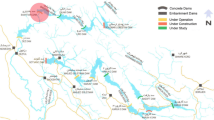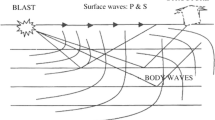Abstract
Estimation of ground vibration induced by blasting operations is an important task to control the safety issues at the surface mines and civil projects. By reviewing the previous studies, some empirical and soft computing models have been proposed to estimate blast-induced ground vibrations. The main goal of this research is to propose a new predictive model in the field of ground vibration estimation. For this aim, the group method of data handling (GMDH) model which is a type of neural network, is proposed with respect to input parameters including the stemming length, powder factor, burden to spacing ratio, distance from the blast-face, blast-hole depth and maximum charge per delay. Also, the peak particle velocity, as the most common descriptor for evaluating the ground vibration, was selected as the output. The required datasets were collected from a quarry in Penang, Malaysia, using 102 blasting operations. Several criteria such as root mean square error (RMSE) and coefficient of determination (R2) were utilized to determine the reliability of the GMDH. Based on the obtained results, the GMDH forecasting technique with R2 of 0.911 and RMSE of 0.889 can be presented as a powerful technique in predicting the blast-induced ground vibration.





Similar content being viewed by others
References
Khandelwal M, Singh TN (2005) Prediction of blast induced air overpressure in opencast mine. Noise Vib Control Worldw 36:7–16
Trivedi R, Singh TN, Gupta N (2015) Prediction of blast-induced flyrock in opencast mines using ANN and ANFIS. Geotech Geol Eng. https://doi.org/10.1007/s10706-015-9869-5
Hasanipanah M, Jahed Armaghani D, Bakhshandeh Amnieh H, Majid MZA, Tahir MMD (2016) Application of PSO to develop a powerful equation for prediction of flyrock due to blasting. Neural Comput Appl. https://doi.org/10.1007/s00521-016-2434-1
Hasanipanah M, Jahed Armaghani D, Monjezi M, Shams S (2016) Risk assessment and prediction of rock fragmentation produced by blasting operation: a rock engineering system. Environ Earth Sci 75:808
Hasanipanah M, Bakhshandeh Amnieh H, Arab H, Zamzam MS (2016) Feasibility of PSO–ANFIS model to estimate rock fragmentation produced by mine blasting. Neural Comput Appl. https://doi.org/10.1007/s00521-016-2746-1
Amiri M, Bakhshandeh Amnieh H, Hasanipanah M, Khanli LM (2016) A new combination of artificial neural network and K-nearest neighbors models to predict blast-induced ground vibration and air-overpressure. Eng Comput. https://doi.org/10.1007/s00366-016-0442-5
Hasanipanah M, Monjezi M, Shahnazar A, Jahed Armaghani D, Farazmand A (2015) Feasibility of indirect determination of blast induced ground vibration based on support vector machine. Measurement 75:289–297
Hasanipanah M, Shahnazar M, Arab H, Bagheri Golzar S, Amiri M (2016) Developing a new hybrid‑AI model to predict blast‑induced backbreak. Eng Comput. https://doi.org/10.1007/s00366-016-0477-7
Jahed Armaghani D, Hasanipanah M, Mohamad ET (2016) A combination of the ICA-ANN model to predict air-overpressure resulting from blasting. Eng Comput 32(1):155–171
Singh TN, Singh R, Singh B, Sharma LK, Singh R, Ansari MK (2016) Investigations and stability analyses of Malin village landslide of Pune district, Maharashtra, India. Nat Hazards 81:2019–2030
Sharma LK, Umrao RK, Singh R, Ahmad M, Singh TN (2017) Stability Investigation of hill cut soil slopes along National Highway 222 at Malshej Ghat, Maharashtra. J Geol Soc India 89(2):165–174
Sharma LK, Umrao RK, Singh R, Ahmad M, Singh TN (2017) Geotechnical characterization of road cut hill slope forming unconsolidated geo-materials: a case study. Geotech Geol Eng 35:503–515. https://doi.org/10.1007/s10706-016-0093-8
Konya CJ, Walter EJ (1985) Rock Blasting, United States Government Printing Office
ISRM (1992) Suggested method for blast vibration monitoring. Int J Rock Mech Min Geomech Abstr 29:145–156
Khandelwal M, Singh TN (2007) Evaluation of blast-induced ground vibration predictors. Soil Dyn Earthq Eng 27:116–125
Hasanipanah M, Shirani Faradonbeh R, Bakhshandeh Amnieh H, Jahed Armaghani D, Monjezi M (2016) Forecasting blast‑induced ground vibration developing a CART model. Eng Comput. https://doi.org/10.1007/s00366-016-0475-9
Fouladgar N, Hasanipana M, Bakhshandeh Amnieh H (2016) Application of cuckoo search algorithm to estimate peak particle velocity in mine blasting. Eng Comput. https://doi.org/10.1007/s00366-016-0463-0
Singh TN, Singh V (2005) An intelligent approach to prediction and control ground vibration in mines. Geotech Geolog Eng 23:249–262
Singh TN, Verma AK (2010) Sensitivity of total charge and maximum charge per delay on ground vibration. Geomat Nat Hazards Risk 1(3):259–272
Verma AK, Singh TN (2013) Comparative study of cognitive systems for ground vibration measurements. Neural Comput Appl 22:341–1643
Monjezi M, Ghafurikalajahi M, Bahrami A (2011) Prediction of blast induced ground vibration using artificial neural networks. Tunn Undergr Space Technol 26:46–50
Monjezi M, Hasanipanah M, Khandelwal M (2013) Evaluation and prediction of blast-induced ground vibration at Shur River Dam, Iran, by artificial neural network. Neural Comput Appl 22:1637–1643
Hasanipanah M, Shahnazar A, Bakhshandeh Amnieh H, Jahed Armaghani D (2016) Prediction of air-overpressure caused by mine blasting using a new hybrid PSO–SVR model. Eng Comput. https://doi.org/10.1007/s00366-016-0453-2
Jahed Armaghani D, Momeni E, Alavi Nezhad Khalil Abad SV, Khandelwal M (2015) Feasibility of ANFIS model for prediction of ground vibrations resulting from quarry blasting. Environ Earth Sci. https://doi.org/10.1007/s12665-015-4305-y
Langefors U, Kihlstrom B (1963) The modern technique of rock blasting. Wiley, New York
Ambraseys NR, Hendron AJ (1968) Dynamic behavior of rock masses: rock mechanics in engineering practices. Wiley, London
Dowding CH (1985) Blast vibration monitoring and control. Prentice-Hall, Englewoods Cliffs, pp 288–290
Rai R, Singh TN (2004) A new predictor for ground vibration prediction and its comparison with other predictors. Indian J Eng Mater Sci 11(3):178–184
Ghasemi E, Ataei M, Hashemolhosseini H (2012) Development of a fuzzy model for predicting ground vibration caused by rock blasting in surface mining. J Vib Control 19(5):755–770
Sharma LK, Vishal V, Singh TN (2017) Developing novel models using neural networks and fuzzy systems for the estimation of strength of rocks from key geomechanical properties. Measurement 102:158–169
Singh R, Umrao RK, Ahmad M, Ansari MK, Sharma LK, Singh TN (2017) Prediction of geomechanical parameters using soft computing and multiple regression approach. Measurement 99:108–119
Sharma LK, Vishal V, Singh TN (2017) Predicting CO2 permeability of bituminous coal using statistical and adaptive neuro-fuzzy analysis. J Nat Gas Sci Eng. https://doi.org/10.1016/j.jngse.2017.02.037
Sharma LK, Singh R, Umrao RK, Sharma KM, Singh TN (2017) Evaluating the modulus of elasticity of soil using soft computing system. Eng Comput 33(3):497–507
Sharma LK, Singh TN (2017) Regression based models for the prediction of unconfined compressive strength of artificially structured soil. Eng Comput. https://doi.org/10.1007/s00366-017-0528-8
Ahmad M, Ansari MK, Sharma LK, Singh R, Singh TN (2017) Correlation between strength and durability indices of rocks-soft computing approach. Proc Eng 191:458–466
Madandoust R, Bungey JH, Ghavidel R (2012) Prediction of the concrete compressive strength by means of core testing using GMDH-type neural network and ANFIS models. Comput Mater Sci 51(1):261–272
Kordnaeij A, Kalantary F, Kordtabar B, Mola-Abasi H (2015) Prediction of recompression index using GMDH-type neural network based on geotechnical soil properties. Soils Found 55(6):1335–1345
Hassanlourad M, Ardakani A, Kordnaeij A, Mola-Abasi H (2017) Dry unit weight of compacted soils prediction using GMDH-type neural network. Eur Phys J Plus 132:357
Ivakhnenko AC (1971) Polynomial theory of complex systems. IEEE Trans Syst Man Cybern 1:364–378
Dag O, Yozgatligil C (2016) GMDH: an R package for short term forecasting via GMDH Type neural network algorithms. R J 8(1):379–386
Nariman-zadeh N, Atashkari K, Jamali A, Pilechi A, Yao X (2005) Inverse modelling of multi-objective thermodynamically optimized turbojet engines using GMDH-type neural networks and evolutionary algorithms. J Eng Optim 37:437–462
Mozaffari A, Azad NL, Hedrick JK, Taghavipour A (2016) A hybrid switching predictive controller with proportional integral derivative gains and GMDH neural representation of automotive engines for coldstart emission reductions. Eng Appl Artif Intell 48:72–94
Duvall WI, Petkof B (1959) Spherical propagation of explosion generated strain pulses in rock. US Bureau of Mines Report of Investigation 5483
Singh TN, Dontha LK, BhardwajV (2008) Study into blast vibration and frequency using ANFIS and MVRA. Min Technol 117:116–121
Jahed Armaghani D, Hajihassani M, Mohamad ET, Marto A, Noorani SA (2014) Blasting-induced flyrock and ground vibration prediction through an expert artificial neural network based on particle swarm optimization. Arab J Geosci 7(12):5383–5396
Taheri K, Hasanipanah M, Bagheri Golzar S, Abd Majid MZ (2017) A hybrid artificial bee colony algorithm-artificial neural network for forecasting the blast-produced ground vibration. Eng Comput. https://doi.org/10.1007/s00366-016-0497-3
Hasanipanah M, Jahed Armaghani D, Khamesi H, Bakhshandeh Amnieh H, Ghoraba S (2015) Several non-linear models in estimating air-overpressure resulting from mine blasting. Eng Comput. https://doi.org/10.1007/s00366-015-0425-y
Demuth H, Beale M, Hagan M (2009) MATLAB Version 7.14.0.739; Neural Network Toolbox for Use with Matlab. The Mathworks
Shirani Faradonbeh R, Jahed Armaghani D, Abd Majid MZ, Tahir MMD, Ramesh Murlidhar B, Monjezi M, Wong HM (2016) Prediction of ground vibration due to quarry blasting based on gene expression programming: a new model for peak particle velocity prediction. Int J Environ Sci Technol. https://doi.org/10.1007/s13762-016-0979-2
Jahed Armaghani D, Hajihassani M, Monjezi M, Mohamad ET, Marto A, Moghaddam MR (2015) Application of two intelligent systems in predicting environmental impacts of quarry blasting. Arab J Geosci 8:9647–9665
Ghoraba S, Monjezi M, Talebi N, Jahed Armaghani D, Moghaddam MR (2016) Estimation of ground vibration produced by blasting operations through intelligent and empirical models. Environ Earth Sci 75:1137
Yang Y, Zhang Q (1997) A hierarchical analysis for rock engineering using artificial neural networks. Rock Mech Rock Eng 30:207–222
Acknowledgements
The authors would like to extend their appreciation to the Government of Malaysia and Universiti Teknologi Malaysia for providing the required facilities to conduct this study possible.
Author information
Authors and Affiliations
Corresponding author
Rights and permissions
About this article
Cite this article
Mokfi, T., Shahnazar, A., Bakhshayeshi, I. et al. Proposing of a new soft computing-based model to predict peak particle velocity induced by blasting. Engineering with Computers 34, 881–888 (2018). https://doi.org/10.1007/s00366-018-0578-6
Received:
Accepted:
Published:
Issue Date:
DOI: https://doi.org/10.1007/s00366-018-0578-6




